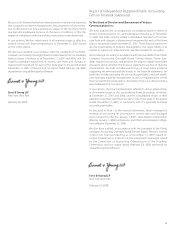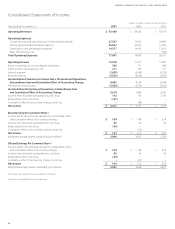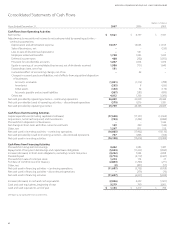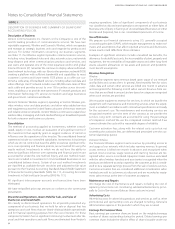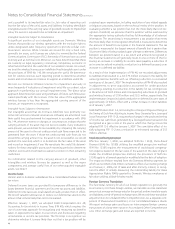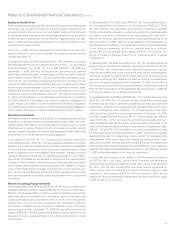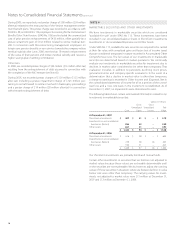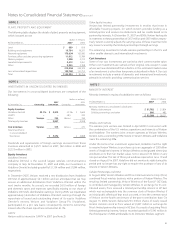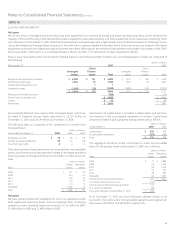Verizon Wireless 2007 Annual Report Download - page 49
Download and view the complete annual report
Please find page 49 of the 2007 Verizon Wireless annual report below. You can navigate through the pages in the report by either clicking on the pages listed below, or by using the keyword search tool below to find specific information within the annual report.Notes to Consolidated Financial Statements continued
47
Employee Benefit Plans
Pension and postretirement health care and life insurance benefits earned
during the year as well as interest on projected benefit obligations are
accrued currently. Prior service costs and credits resulting from changes
in plan benefits are amortized over the average remaining service period
of the employees expected to receive benefits. Expected return on plan
assets is determined by applying the return on assets assumption to the
market-related value of assets.
As of July 1, 2006, Verizon management employees no longer earn
pension benefits or earn service towards the company retiree medical
subsidy (see Note 15).
In September 2006, the FASB issued SFAS No. 158, Employers’ Accounting
for Defined Benefit Pension and Other Postretirement Plans—an amendment
of FASB Statements No. 87, 88, 106, and 132(R) (SFAS No. 158). Effective
December 31, 2006, SFAS No. 158 requires the recognition of a defined
benefit postretirement plan’s funded status as either an asset or liability
on the balance sheet. SFAS No. 158 also requires the immediate recog-
nition of the unrecognized actuarial gains and losses and prior service
costs and credits that arise during the period as a component of other
accumulated comprehensive income, net of applicable income taxes.
Additionally, the fair value of plan assets must be determined as of the
Company’s year-end. We adopted SFAS No. 158 effective December
31, 2006, which resulted in a net decrease to shareowners’ investment
of $7,409 million. This included a net increase in pension obligations of
$2,007 million, an increase in Other Postretirement Benefits Obligations
of $10,828 million and an increase in Other Employee Benefit Obligations
of $31 million, offset by an increase in deferred taxes of $5,457 million.
Derivative Instruments
We have entered into derivative transactions to manage our exposure to
fluctuations in foreign currency exchange rates, interest rates and com-
modity prices. We employ risk management strategies using a variety
of derivatives including foreign currency forwards and collars, equity
options, interest rate and commodity swap agreements and interest rate
locks. We do not hold derivatives for trading purposes.
In accordance with SFAS No. 133, Accounting for Derivative Instruments
and Hedging Activities (SFAS No. 133) and related amendments and inter-
pretations, we measure all derivatives, including derivatives embedded
in other financial instruments, at fair value and recognize them as either
assets or liabilities on our consolidated balance sheets. Changes in the fair
values of derivative instruments not qualifying as hedges or any ineffec-
tive portion of hedges are recognized in earnings in the current period.
Changes in the fair values of derivative instruments used effectively as fair
value hedges are recognized in earnings, along with changes in the fair
value of the hedged item. Changes in the fair value of the effective por-
tions of cash flow hedges are reported in other comprehensive income
(loss) and recognized in earnings when the hedged item is recognized
in earnings.
Recent Accounting Pronouncements
In December 2007, the FASB issued SFAS No. 141(R), Business Combinations
(Revised), (SFAS No. 141(R)), to replace SFAS No. 141, Business Combinations.
SFAS No. 141(R) requires the use of the acquisition method of accounting,
defines the acquirer, establishes the acquisition date and broadens the
scope to all transactions and other events in which one entity obtains
control over one or more other businesses. This statement is effective
for business combinations or transactions entered into for fiscal years
beginning on or after December 15, 2008. We are still evaluating the
impact of SFAS No. 141(R), however, the adoption of this statement is not
expected to have a material impact on our financial position or results
of operations.
In December 2007, the FASB issued SFAS No. 160, Noncontrolling Interests
in Consolidated Financial Statements – an amendment of ARB No. 51, (SFAS
No. 160). SFAS No. 160 establishes accounting and reporting standards
for the noncontrolling interest in a subsidiary and for the retained interest
and gain or loss when a subsidiary is deconsolidated. This statement is
effective for financial statements issued for fiscal years beginning on or
after December 15, 2008. Upon the initial adoption of this statement we
will change the classification and presentation of Noncontrolling Interest
in our financial statements, which we currently refer to as minority
interest. We are still evaluating the impact SFAS No. 160 will have, but
we do not expect a material impact on our financial position or results
of operations.
In February 2007, the FASB issued SFAS No. 159, The Fair Value Option for
Financial Assets and Financial Liabilities – Including an Amendment of SFAS
115 (SFAS No. 159), which permits but does not require us to measure
financial instruments and certain other items at fair value. Unrealized gains
and losses on items for which the fair value option has been elected are
reported in earnings. This statement is effective for financial statements
issued for fiscal years beginning after November 15, 2007. As we will not
elect to fair value any of our financial instruments under the provisions of
SFAS No.159, the adoption of this statement effective January 1, 2008 will
not have any impact on our financial statements.
In September 2006, the FASB issued SFAS No. 157, Fair Value Measurements
(SFAS No. 157). SFAS No. 157 defines fair value, establishes a framework
for measuring fair value in generally accepted accounting principles and
establishes a hierarchy that categorizes and prioritizes the sources to be
used to estimate fair value. SFAS No. 157 also expands financial state-
ment disclosures about fair value measurements. On February 12, 2008,
the FASB issued FASB Staff Position (FSP) 157-2 which delays the effective
date of SFAS No. 157 for one year, for all nonfinancial assets and non-
financial liabilities, except those that are recognized or disclosed at fair
value in the financial statements on a recurring basis (at least annually).
SFAS No. 157 and FSP 157-2 are effective for financial statements issued
for fiscal years beginning after November 15, 2007. We will elect a partial
deferral of SFAS No. 157 under the provisions of FSP 157-2 related to the
measurement of fair value used when evaluating goodwill, other intan-
gible assets, wireless licenses and other long-lived assets for impairment
and valuing asset retirement obligations and liabilities for exit or disposal
activities. The impact of partially adopting SFAS No. 157 effective January
1, 2008 will not be material to our financial statements.
In June 2006, the Emerging Issues Task Force (EITF) reached a consensus
on EITF No. 06-3, How Taxes Collected from Customers and Remitted to
Governmental Authorities Should Be Presented in the Income Statement (EITF
No. 06-3). EITF No. 06-3 permits that such taxes may be presented on
either a gross basis or a net basis as long as that presentation is used
consistently. The adoption of EITF No. 06-3 on January 1, 2007 did not
impact our financial statements. We present the taxes within the scope
of EITF No. 06-3 on a net basis.




